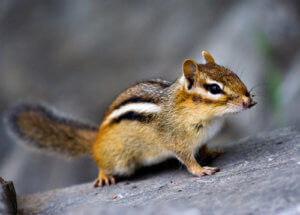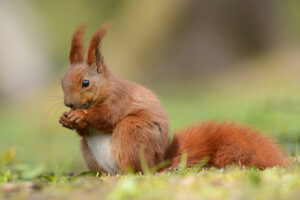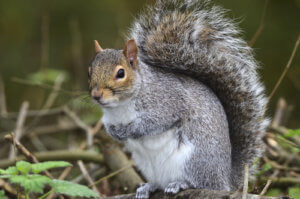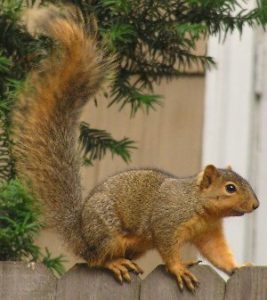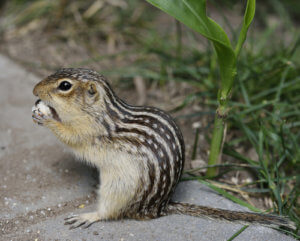Squirrels, some of nature’s cheekiest creatures. We can agree that they are furry, cute, and quite entertaining to watch; however, these animals are rodents and ultimately cause health and safety issues for property owners. Squirrels can cause extensive structural damage to homes and other buildings, ruin crops, even harm other animals by raiding bird’s nests for eggs and chicks. Their droppings spread salmonella and can make humans sick. Our great state of Michigan has six species: the Eastern Chipmunk, Flying, Red, Grey, Fox, and the Thirteen-lined Ground. Proper identification is key in eradicating a squirrel issue, and there are many traits that distinguish one species from another. Apart from damaging crops and threatening bird populations, each species has specific tendencies when taking over a property or structure.
Eastern Chipmunk
Unlike other species, Chipmunk tend to stay on the ground. These squirrels do not use trees or wires for access into a structure. They prefer to exploit an open gap at the base of the structure or chew in through the garage door seal. Once inside they will begin to rummage through things, looking for bird seed or other food storage in the garage. They also chew on wires in the garage or on a car. Chipmunks are carnivorous and known to raid bird nests for eggs and chicks. Chipmunks are typically not hard to control, unlike Red, Grey, and Flying Squirrels.
Flying Squirrel
The most carnivorous, these squirrels are nocturnal and are rarely seen during the day. Flying Squirrels can be very loud in attics; they can also be mistook for a larger animals, such as a raccoon. They enter homes through holes in the soffit, window and door frames, and can chew holes in siding. Flying Squirrels can have multiple den sites; a reason some homeowners believe the problem is gone for good after not hearing any movement for awhile. It is best to trap double digits before declaring the problem eradicated.
Red Squirrel
Nicknamed “red devils” these squirrels nest inside structures and are one of Northern Michigan’s most common problems. Once this happens, it will typically turn into a generational situation and continue for years until something is done. Red Squirrels are excellent climbers; they will use anything close to the home to obtain access to a structure. Red Squirrels will even jump off close access points if nothing is touching! They will chew into the home through the ridge vent, soffit, dormer, crawl space vent, or any other pipe or open gap on a home. Red Squirrels are even known to chew into cedar sided and log homes to obtain direct access.
Grey Squirrel
Grey Squirrels do not tend to chew into structures as much as other species, but they do tend to exploit pre-existing gaps. Once inside, they begin to nest and reproduce, however it is to be noted that Grey Squirrels have multiple den sites and will live elsewhere when not reproducing. Northern Michigan does not see as big of an issue with Grey Squirrels as it does with other species, but they can still cause a disturbance once inside. Like the Eastern Chipmunk, Grey Squirrels are known to be nest-raiders and will consume bird eggs and chicks.
Fox Squirrel
The Fox Squirrel spends more time on the ground than other squirrels and is most active during the day. They enjoy raiding birdhouses to eat eggs and hatchlings but also invade bird feeders, attics, sheds, and garages.
Thirteen-Lined Ground
It is extremely rare to find the Thirteen-Lined Ground squirrel inside of structures. Rather than chewing inside, these squirrels will do their damage outside in the yard. They cause problems with erosion, tear up gardens, and create burrows and holes around the property.
Despite all of their differences, the best method for eradication is by trapping, removing, and maintaining by a licensed wildlife professional. We pride ourselves in staying on the cutting-edge of this type of trapping and have recently implemented new technology that allows customers to get a never-before-seen view of our work. The Arlo camera provides us with a live feed whenever movement is detected in an infested space— we share the videos with the customer which is both an extremely effective tool, but a bonus other trappers do not provide (but more on the Arlo later!). If you are hearing noises in your attic or walls, seeing new or larger than usual holes on the exterior of a structure, or seeing squirrels ransacking your bird feeders, please give us a call.
